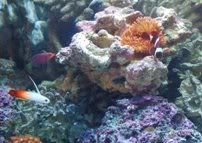red slime algae! i had to deal with it. i bought a red slime remover that is a yellow powder you mix with your tank water. i treated mine and in 3 days 80% of it turned brown and dried up. it says to treat twice and that took care of it all in less than a week. i bought mine at a lfs for $20, but i found it cheaper several places on line. below is just one site. i just wanted you to see the product i was talking about. by the way it had no noticeable effect on any of my corals, fish or invertebrates,
https://www82.safesecureweb.com/weba...me_remover.jpg





 Reply With Quote
Reply With Quote









 to TR.
to TR. If I get another outbreak I will do the same thing, go the natural route and only resort to chemicals after several weeks.
If I get another outbreak I will do the same thing, go the natural route and only resort to chemicals after several weeks. 


 , does feeding live phyto to the corals help algae grow or sustain it? does algae absorb phyto? cleaning the thin green film algae off the glass with the a magnet allows it to mix with the water. do corals and maybe my clam eat this while its in the water? i know it allows it to grow back fast.( i think i'm still going through a mini cycle due to my tank upgrade 3 weeks ago.) the brown algae i first had has now turned green. how long should this last? will it go away on its own once the tank has finished cycling? (I'm working on some underlying problems i have now also).
, does feeding live phyto to the corals help algae grow or sustain it? does algae absorb phyto? cleaning the thin green film algae off the glass with the a magnet allows it to mix with the water. do corals and maybe my clam eat this while its in the water? i know it allows it to grow back fast.( i think i'm still going through a mini cycle due to my tank upgrade 3 weeks ago.) the brown algae i first had has now turned green. how long should this last? will it go away on its own once the tank has finished cycling? (I'm working on some underlying problems i have now also).



 Vquilibrium Productions
Vquilibrium Productions

Bookmarks